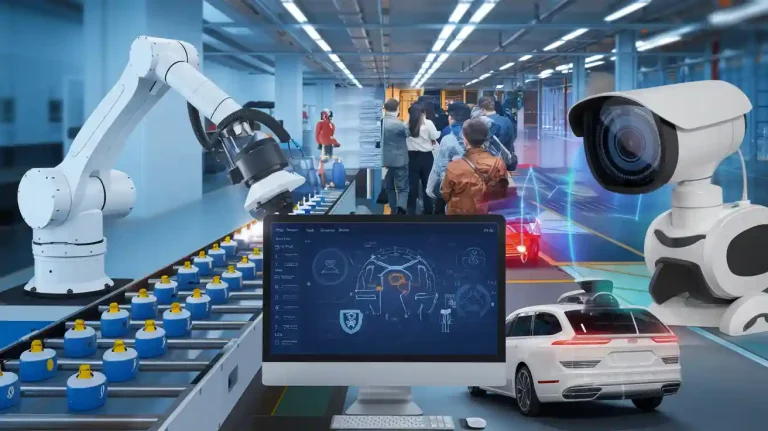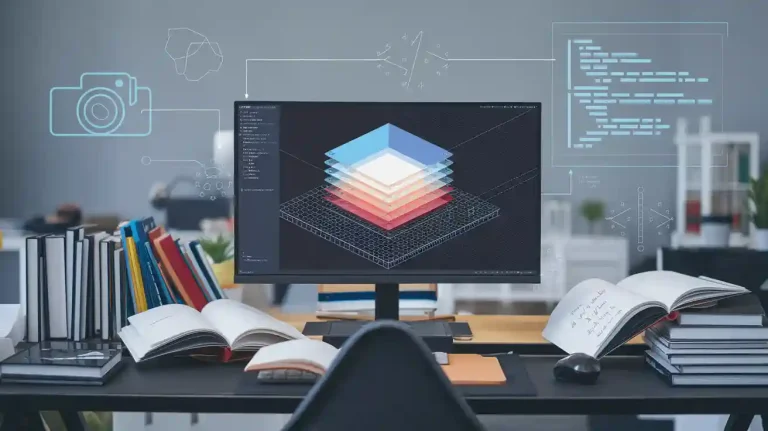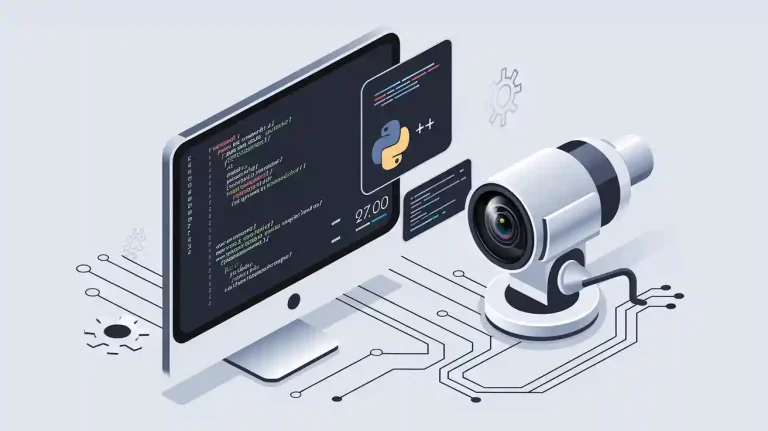A keras machine vision system helps you teach computers to understand images and video using convolutional methods. You use keras, a deep learning api, to make this process simple. With a keras machine vision system, you can solve computer vision tasks like image classification by working with images and data. Keras stands out for beginners because you can quickly build models for computer vision.
Keras is popular for education and small projects, while TensorFlow and PyTorch lead in large-scale computer vision tasks.
| Framework | Best For | Strengths |
|---|---|---|
| Keras | Learning, Prototyping | Easy, Fast, Accessible |
| TensorFlow | Production | High Performance |
| PyTorch | Research | Flexible, Innovative |
Key Takeaways
- Keras is a simple and powerful tool that helps you build deep learning models for computer vision tasks like image classification and object detection.
- You can use Keras to quickly prepare data, create convolutional neural networks, and train models with easy-to-use code and helpful features like data augmentation.
- Starting with popular datasets like MNIST or CIFAR-10 makes learning and experimenting with Keras machine vision systems easier and more effective.
- Transfer learning with pretrained models saves time and improves accuracy, especially when you have limited data.
- Evaluating your model with the right metrics and using tips like tuning hyperparameters and monitoring training helps you build better and more accurate vision systems.
Keras Machine Vision System
What Is Keras?
Keras is a high-level deep learning API that helps you build and train deep neural networks. You use it to create models for tasks like computer vision and video analysis. Keras started as an independent library, but now it works closely with TensorFlow as its main interface. You can also use it with other backends, such as Theano or Microsoft Cognitive Toolkit. Keras gives you two main ways to build models: the Sequential API for simple stacks and the Functional API for more complex networks. This flexibility lets you design both basic and advanced architectures for computer vision.
A keras machine vision system uses Keras to help computers see and understand images and video. You can use convolutional layers to find patterns, activation functions to help the network learn, and pooling layers to make your models faster. Keras makes it easy to build these systems, so you can focus on solving real-world problems.
Keras stands out because it makes building deep models simple and accessible. You do not need to worry about the complex details of deep learning. You can focus on your data and your results.
Why Use Keras for Machine Vision?
You might wonder why so many people choose Keras for computer vision. Here are some reasons:
- Keras is a high-level neural network library designed to improve accessibility and simplify deep learning.
- It provides a high-level API that abstracts complex deep learning details, allowing you to focus on model design.
- You get pre-built layers, optimizers, and activation functions, which help you build models quickly.
- Keras is written in Python, so it is easy for Python programmers to use.
- The framework emphasizes simplicity, adaptability, and faster experimentation compared to other frameworks.
- Keras acts as a user-friendly front-end interface for TensorFlow, not as a standalone deep learning framework.
When you use a keras machine vision system, you can solve many computer vision tasks. These include:
| Computer Vision Task | Description | Real-World Applications |
|---|---|---|
| Image Classification | Assigns labels to images, identifying main content. | Object recognition, medical imaging. |
| Object Detection | Finds and locates objects in images or video using bounding boxes. | Pedestrian detection, autonomous driving. |
| Image Segmentation | Divides images into meaningful regions. | Tumor detection, autonomous driving. |
| Face and Person Recognition | Identifies people by facial features or body attributes. | Security, surveillance, access control. |
| Edge Detection | Finds boundaries between objects by highlighting intensity changes. | Autonomous vehicles, medical image analysis. |
| Image Restoration | Recovers and enhances damaged images. | Digital photography, forensic science. |
| Feature Matching | Finds matching features across images for recognition and stitching. | Augmented reality, 3D scene construction. |
| Scene Reconstruction | Creates 3D models from images. | VR/AR, autonomous navigation. |
| Video Motion Analysis | Detects and interprets motion patterns in video sequences. | Surveillance, activity recognition. |
You can use Keras to build models for all these tasks. The keras machine vision system uses convolutional neural networks to process data from images and video. You can use the MNIST dataset to practice image recognition, or try more advanced datasets for object detection.
KerasCV and Keras Vision Models extend Keras for vision tasks. KerasCV gives you special tools for data augmentation, object detection, and segmentation. It also supports bounding box-aware data augmentation, which helps you keep your data accurate during training. Keras Vision Models offer state-of-the-art pretrained models, so you can start with a strong base and fine-tune for your own data.
When you use Keras, you get:
- Easy-to-use APIs for building deep models.
- Fast prototyping and quick experiments.
- Seamless integration with TensorFlow for powerful computing.
- Support for large GPU clusters and TPU pods.
- Tools for handling complex model topologies, such as networks with multiple inputs or outputs.
Keras is a great choice if you want to learn computer vision, build prototypes, or work in a small team. You can focus on your data and your results, not on the details of the framework. While Keras is not as flexible as PyTorch or as powerful as TensorFlow for large-scale production, it is perfect for most learning and prototyping needs.
Core Components
Convolutional Neural Network
You use a convolutional neural network (CNN) as the main engine in a keras machine vision system. CNNs help you process images and video by scanning for patterns. Each convolutional layer uses small filters to find edges, shapes, and textures in your data. These networks learn to recognize features from simple lines to complex objects. You can stack many convolutional layers to build deep networks that solve tasks like image classification and object detection.
Keras lets you add convolutional layers with just a few lines of code. You do not need to handle the math behind the scenes. CNNs have changed computer vision since 2012. They now reach or even beat human accuracy in many tasks. You see CNNs in face recognition, medical imaging, and self-driving cars. The table below shows how CNNs work in keras machine vision systems:
| Aspect | Details |
|---|---|
| Role of CNNs | Extract features from images using convolutional filters |
| Keras Support | Simple API for adding convolutional layers and building deep networks |
| Performance | High accuracy in classification and detection tasks |
| Applications | Used in face recognition, tumor detection, robotics, and security |
| Efficiency | Less preprocessing needed, fast end-to-end learning |
You can use advanced CNNs like Faster R-CNN for real-time object detection. Deeper networks often give better accuracy for large datasets.
Data and Preprocessing
Good data is the foundation of any keras machine vision system. You start by organizing your images into folders for training, validation, and testing. Each class, like "cat" or "dog," gets its own folder. You load images with Keras tools such as flow_from_directory(), which helps you manage labels and resize images.
Data augmentation is a key step. You use it to create new images by rotating, flipping, or changing colors. This makes your dataset bigger and more varied. Augmentation helps your model avoid overfitting and improves accuracy. Keras provides the ImageDataGenerator for real-time augmentation during training.
Tip: Always apply augmentation only to your training data, not to validation or test sets.
Transfer learning lets you use pretrained models on new data. This saves time and boosts accuracy, especially if you have a small dataset. You can use popular datasets like CIFAR-10 or Fashion MNIST for practice. The chart below shows the size of some common datasets:
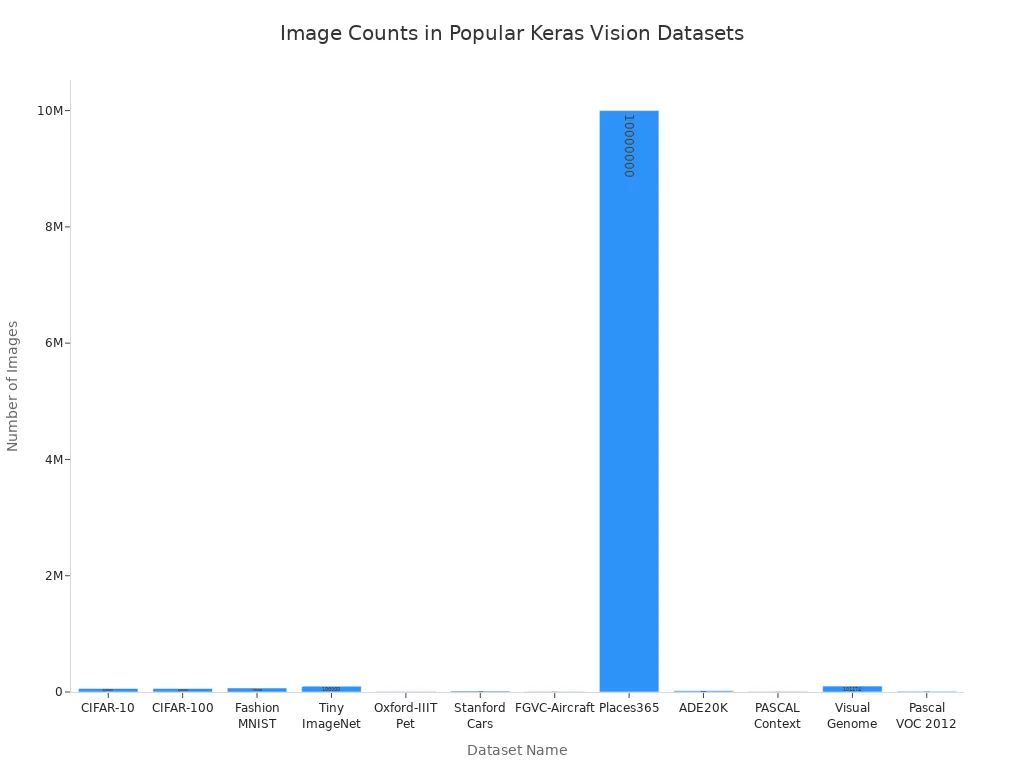
You need to normalize your images by scaling pixel values. This helps the model learn faster. Quality data and careful preprocessing lead to better results in classification and other computer vision tasks.
Build a Keras Vision Model
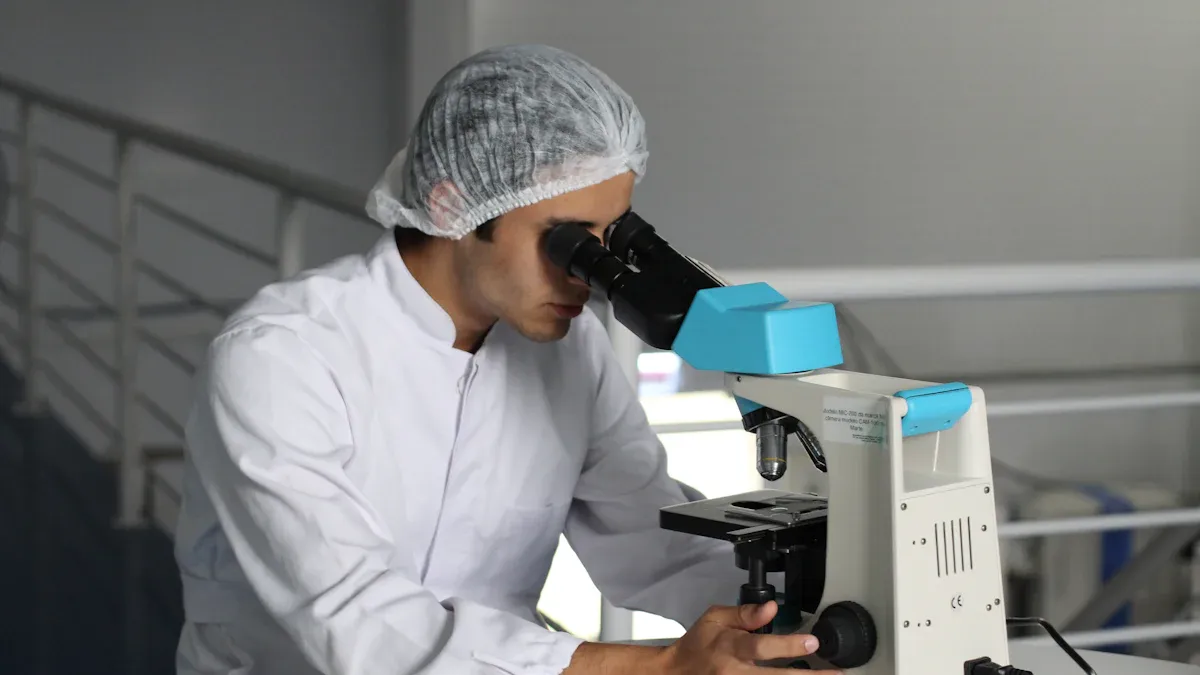
Building a vision model with keras gives you a clear path from raw images to a working classification system. You can follow these steps to create your own keras machine vision system.
Select a Dataset
You start by choosing a dataset that matches your project goals. Popular choices include mnist and cifar-10 dataset. The mnist dataset has 70,000 grayscale images of handwritten digits, each 28×28 pixels. The cifar-10 dataset contains 60,000 color images, each 32×32 pixels, across 10 classes like airplanes, cars, and birds. You can use mnist for simple projects or cifar-10 dataset for more complex tasks.
When you select a dataset, consider:
- The number of images and classes. More images help your model learn better.
- The shape and color channels. mnist uses grayscale, while cifar-10 dataset uses color.
- The complexity of the images. Fashion mnist is harder than mnist and helps you test deeper networks.
- The type of problem. Decide if you want to do classification, regression, or clustering.
- The quality and balance of the data. Make sure the images are clear and the classes are balanced.
Tip: Start with mnist or cifar-10 dataset if you are new to keras. These datasets are easy to load and use.
Prepare Data
After you pick your dataset, you need to prepare the data for training. This step helps your cnn learn faster and reach higher accuracy. You should:
- Split your data into training, validation, and test sets. Training data teaches your model. Validation data checks your model during training. Test data measures final accuracy.
- Normalize your images by scaling pixel values to a range between 0 and 1. This helps the network learn better.
- Reshape images if needed. For mnist, add a channel dimension to get (28, 28, 1). For cifar-10 dataset, use (32, 32, 3).
- Use data augmentation to make your training data more diverse. You can flip, rotate, or zoom images. KerasCV makes this easy with built-in augmentation layers.
Here is an example of data augmentation in keras:
from tensorflow.keras.preprocessing.image import ImageDataGenerator
datagen = ImageDataGenerator(
rotation_range=30,
width_shift_range=0.1,
height_shift_range=0.1,
horizontal_flip=True,
rescale=1./255
)
Data augmentation helps your cnn avoid overfitting and improves accuracy. You can also use keras preprocessing layers like Resizing and Rescaling to standardize your images.
Create a CNN Model
Now you build your cnn using keras. A cnn uses convolutional layers to scan images for patterns. You stack convolutional layers, pooling layers, and dense layers to create a deep network for classification.
Here is a simple cnn for the cifar-10 dataset:
from tensorflow.keras import layers, models
model = models.Sequential([
layers.Conv2D(32, (3, 3), activation='relu', input_shape=(32, 32, 3)),
layers.MaxPooling2D((2, 2)),
layers.Conv2D(64, (3, 3), activation='relu'),
layers.MaxPooling2D((2, 2)),
layers.Conv2D(64, (3, 3), activation='relu'),
layers.Flatten(),
layers.Dense(64, activation='relu'),
layers.Dense(10, activation='softmax')
])
- Convolutional layers find features in images.
- Pooling layers reduce image size and keep important information.
- Flatten layers turn the 2D data into a 1D vector.
- Dense layers perform the final classification.
You can use the Sequential API for simple models or the Functional API for more complex networks. Set hyperparameters like the number of filters, kernel size, and pool size to tune your cnn.
Note: For small datasets, try transfer learning. Use a pretrained model like VGG or ResNet from keras applications. Fine-tune the model for your own data. This boosts accuracy and saves training time.
Train and Evaluate
You now train your cnn on the prepared data. Compile your model with an optimizer, loss function, and metrics. For classification, use categorical_crossentropy loss and accuracy as a metric.
model.compile(optimizer='adam',
loss='categorical_crossentropy',
metrics=['accuracy'])
Start the training process with the fit() method. Set the number of epochs and batch size. Use validation data to check accuracy during training.
history = model.fit(train_images, train_labels,
epochs=10,
batch_size=64,
validation_data=(val_images, val_labels))
After training, evaluate your model on the test set. Check metrics like accuracy, precision, recall, and F1-score. These metrics help you understand how well your cnn performs on classification tasks.
- Accuracy shows the percentage of correct predictions.
- Precision and recall give more details for each class.
- F1-score balances precision and recall.
You can also use a confusion matrix to see where your model makes mistakes.
Tip: If your accuracy is low, try more data augmentation, deeper networks, or transfer learning with pretrained models.
With keras and tensorflow, you can build, train, and evaluate deep cnn models for computer vision. You can use mnist or cifar-10 dataset to practice. Data preparation, careful model design, and good training process help you reach high accuracy in classification.
Improve and Interpret
Model Evaluation
You need to check how well your model works after training. For computer vision tasks, you use different metrics based on your goal. If you work on classification, you look at accuracy, precision, and recall. These metrics come from the confusion matrix, which shows how many images your model predicts correctly or incorrectly. For object detection, you use Intersection over Union (IoU) to see if your model finds objects in the right place. Metrics like Average Precision (AP) and mean Average Precision (mAP) help you measure accuracy for bounding boxes. You often use mAP@0.5 for a basic check, but mAP@0.9 gives a stricter test.
- Use
model.evaluate()in Keras to get accuracy and loss on your test data. - Try
model.predict()to see how your model performs on new images or video. - Pick the right metric for your task to get reliable results.
- Use statistical tests carefully to compare models, and always check the assumptions behind these tests.
Tip: Always use a separate test set to measure accuracy. This helps you avoid overfitting and gives a true picture of your model’s performance.
Tips for Better Results
You can improve your model by following some simple steps:
- Define your problem and set clear success metrics before training.
- Clean and prepare your data carefully. Good data leads to better accuracy.
- Build a training pipeline that lets you test changes quickly.
- Use both exploration and exploitation for optimisation. Try different settings, then focus on the best ones.
- Treat some parameters as fixed, some as under study, and some as nuisance. This helps you understand what affects accuracy.
- Choose the largest batch size that fits your GPU for faster training.
- Watch your training curves and weight histograms to spot problems early.
- Automate plots of accuracy and loss to see trends during training.
- Use tools like Keras-Tuner for smart optimisation of hyperparameters.
- Ask clear questions with each experiment to learn and improve your model.
To interpret your model, you can use methods like Integrated Gradients or occlusion. These techniques show which parts of an image matter most for your model’s prediction. You can also visualize filters and feature maps to see what your model learns during training.
| Parameter | OpenCV | Keras (with TensorFlow backend) |
|---|---|---|
| Ease of use | Good for beginners, strong documentation | Very beginner-friendly, fast prototyping |
| Performance | Great for real-time and classic tasks | Strong for deep learning and large datasets |
OpenCV works best for real-time video and traditional computer vision. Keras helps you build deep models for tasks like image classification and object detection. You choose the tool that fits your data and training needs.
You explored the essentials of a keras machine vision system, from selecting datasets like mnist and cifar-10 dataset to building and evaluating a cnn for image classification and object detection. Keras stands out for its user-friendly design, clear documentation, and open resources, making deep learning accessible for beginners.
Start experimenting with transfer learning, try new datasets, and use community tutorials to deepen your skills. Continuous learning and hands-on projects will help you master computer vision and achieve better accuracy in your models.
FAQ
What is the easiest way to start with a keras machine vision system?
You can start by loading the mnist or cifar-10 dataset in keras. Use the Sequential API to build a simple convolutional neural network. Try image classification first. Keras gives you tools to handle images, training, and evaluation with just a few lines of code.
How does transfer learning help improve accuracy in computer vision tasks?
Transfer learning lets you use a pretrained model, like one trained on ImageNet, for your own images. You save time and boost accuracy, especially with small datasets. You can fine-tune the network for tasks like object detection or classification using keras and tensorflow.
Can I use keras for video analysis and object detection?
Yes, you can use keras for video analysis and object detection. You build deep neural networks that process video frames as images. Keras supports convolutional layers and pretrained models for these tasks. You can also use KerasCV for advanced data augmentation and optimisation.
What is the difference between a cnn and a regular neural network in keras?
A cnn uses convolutional layers to scan images for patterns. This helps with image classification and object detection. Regular neural networks do not handle images as well. Convolutional neural networks work better for computer vision because they learn features from images and video.
See Also
Understanding The Role Of Synthetic Data In Vision
A Comprehensive Guide To Computer And Machine Vision
Breaking Down Image Processing In Machine Vision Systems







